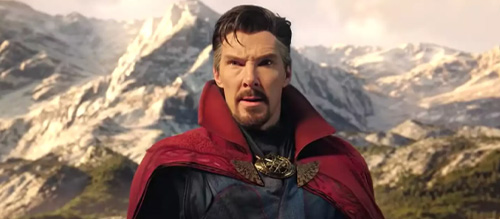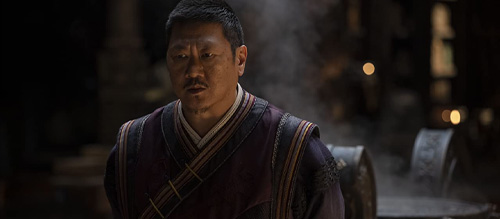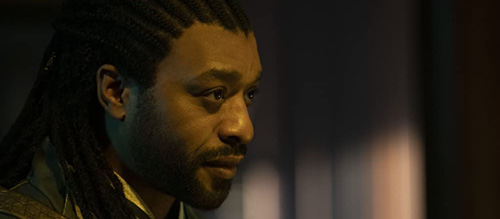Is Marvel’s Insistence on Being So Firmly On-The-Nose Rooted in a Distrust of Its Audience?

In Doctor Strange in the Multiverse of Madness, viewers are spoon-fed characterisation and exposition using dialogue akin to the airplane method weirdly successful with infants. Viewers and fans deserve more credit.
The MCU web is a complex one. Even for those who have keenly watched every film release, and would be confident naming all characters on the board of a Marvel-themed edition of Guess Who, there are a lot of moving parts, both at an individual film level and in the ever-expanding list of crossovers, cameos, and introductions. So much so, that fans are, with every release, becoming more reliant on blog posts and videos to explain these references. With that in mind, wouldn’t some merciful condescension offer some clarity?
Increasingly often, and never more so than in Marvel Studios’ latest offering Doctor Strange in the Multiverse of Madness, we aren’t afforded the privilege. Instead, audiences are left to wonder about – or miss altogether – the myriad of possible connections between characters, between narratives, between universes and even multiverses, instead having the specific plot points broadcast to us in headline phrases. Given the enormous success and budget of Marvel’s visual effects department, it is safe to say that they can be trusted to illustrate events without some of the world’s most famous actors simplifying their performances like they’re a tour guide. But it’s the dialogue that is to blame…
Stronger dialogue is often identified as having two very simple traits: it shows, rather than tells, and; it’s individual and idiomatic. In Michael Waldron’s Multiverse of Madness script, speech does the opposite.
Parts of the film feel like they are a collage of phrases from other Marvel movies, and act purely as a textual description of an on-screen event. Viewers need dialogue to characterise and/or progress the plot, as well as entertain them, but here it is used in a foundational way that feels unfinished. Similar to the production of a first draft, where the script’s job is to build the story’s pillars and walls before they’re painted in subsequent versions with vernacular and believable emotion, Doctor Strange 2’s impressive cast is forced to utter lines that feel like they could have instead been reminders about what CGI was planned for post-production. The experience of watching this film could be noticeably improved by focusing more on allusion, subtext, and inference, rather than by repeatedly staging – and losing – a battle between a line’s quotability and cheese.
Here are some of the worst examples:

‘Kamar-Taj must now become a fortress.’
Wong growls this after a roughly ten-minute insight into Wanda’s commitment to out-do Mrs Doubtfire in reaching her children. Viewers know she’s coming, and for whom, and there is even a neat sequence where all the other sorcerers arrive in defence of the stronghold. Because of these, audiences are capable of inferring that the combative actions and stances of all these characters is a defensive move against Scarlet Witch. So why collapse the tension with a line from an 11-year-old writing a comic book?
Better options for this would be to either: move the plot like this does but in a less derivative way, such as bellowing an imperative to ‘Lock the Gates’; or provide some light-relief in the form of a complaint: ‘When do I get a day off?’ or ‘All you’ve done is give me a headache, Strange’. Wong repeatedly shows this irreverent streak in times of significant tension, so why not then?

‘Come in and tell me everything about your universe’
In one of the other universes Strange visits, he meets previous adversary Baron Mordo, played by Chiwetel Ejiofor, who enthusiastically delivers this line like a welcoming old friend. Of course, this is how (albeit with a little suspicion shared by fans and Strange) he is portrayed in this moment. But this line is too functional and not realistic enough. Instead, the writer could have used another declarative more indicative of a friendly relationship, such as ‘Let’s get you out of that ridiculous coat’, or used an interrogative that characterises, or perhaps is used as a red herring, to incite trust from viewers. This could be, for example, ‘How’s the tea over there (in your universe)?’ or ‘Is Wong still taking himself too seriously?’ Either could be used as a segue into a subsequent scene where Strange explains his predicament or the reality of his universe.
‘Perhaps if I can pull you from the rubble, the spell will break’
The communication of this plot point is simple to fix: it should belong to the visual medium. Aside from some budgetary constraint (which seems an incongruent concept with Marvel), it seems odd to imagine this being a conscious choice, to have this said rather than shown.
Perhaps, for example, initial jerks of the character out of the rubble are met with a hazing, or a stretching of the spell, a cracking in the pattern seen on screen. This option would avoid that squirm-inducing feeling of being patronised, unfortunately present at various points throughout Multiverse of Madness.
There are more of these, notably ‘Go back to hell’ and ‘Face the eternal consequence’, which both seem like direct quotations from director Sam Raimi’s earlier film Drag Me to Hell, but the rules are the same – not enough of the polishing or individualising that makes scripts effective.
So why did they make the final cut? Surely Marvel, with its seemingly infinite resources and clear ability to manage outrageous plot structures, have included this type of dialogue for a specific reason?
In parts, it is easier to see the motive behind the dialogue. For example, Wanda’s intentionally tropey dialogue, continued from ‘Wandavision’ as a symbol of her naivety about family life and longing for mediocrity, is great. Most audiences notice the stock phrases and priorities, and they work successfully as foreshadowing or dramatic irony. In addition, there are parts of the film where the dialogue appears as scaffolding, acting as a stabiliser for younger viewers or those new to the MCU. Even so, to both demographics, the visual medium is surely a more powerful tool. By eliminating this weaker dialogue, writers can avoid some of the ‘Theme Park’ criticisms of Marvel films made by directors such as Martin Scorsese, and allow audiences to focus on other, stronger, elements of the film.
Potentially the most noteworthy strength of Multiverse of Madness is Raimi’s use of horror tropes, which are, despite their frequency, undoubtedly entertaining, as well as contributory towards a darker tone many have called for to be in more Marvel films. The Evil Dead-esque chase sequences, the violence that pushes the limit of PG-13 content, the obligatory hand springing from the ground, all of these are signatures of a director who appreciates the relationship between fear and fun, a balance films such as Venom and Morbius failed to strike. However, what feels nostalgic and, at times, just delightful, in these visual moments feels limiting and, in terms of audience intoxication in story, sobering, in speech. Maybe these aforementioned phrases were intentional, left in or included in meetings with Raimi and Waldron so that the tone of the fan service is complemented in dialogue. Nonetheless, it is difficult to imagine the misguided nature of that choice not becoming all too apparent on the first table-read, or take.
Dialogue is so indicative of tone, so powerful in its ability to manipulate the overall experience of a film, that it needs to be used carefully; its ability to cloud other elements of any given movie is both a tool, and an obstacle. By considering this in the drafting process, and perhaps encouraging more cooperation between screenwriters and visual effects producers, Marvel can climb out of the straight-jacket constraints of conventions it has bound itself in, and trust its audiences more than it currently is.
Written by Callum McGuigan
Recommended for you: 10 Best Sam Raimi Movie Moments


Nailed it, pretty much sums it up for me. I love the Marvel world and look forward to new releases but at times, I wonder if I’m being ‘marvelsplained’ to with the weird comments.